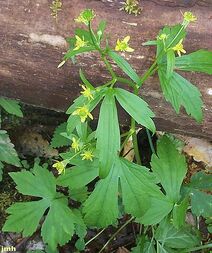Ranunculus pennsylvanicus
| Ranunculus pennsylvanicus | |
 | |
| Light: | |
| Moisture: | |
| Soil pH: | 5.6-8.4 |
| Height: | 3' |
| Native to: | |
| Edible Rating: | |
| Medicinal Rating: | |
| Tea: | Yes |
Ranunculus pennsylvanicus (common name: pennsylvania buttercup) is a forb with yellow flowers that prefers moist loamy soil[1] and grows in meadows, alluvium, and ditches[2] across Canada and Alaska and as far south as Colorado. The leaves are edible as a famine food when cooked to remove a heat sensitive toxin.[3][4][5][6][7][8][9]
Juice from this plant is strongly acrid and is a rubefacient[10] that is used to raise blisters.[10]
Propagation: Seed - sow spring in a cold frame. When they are large enough to handle, prick the seedlings out into individual pots and plant them out in the summer.
A greedy plant, inhibiting the growth of nearby plants, especially legumes[11].
Usage: The entire plant can be boiled to yield a red dye[12]. It is mixed with the bark of bur oak to set the color.[12]
The entire plant can be boiled with rushes (Juncus spp) or flags (Iris spp and Acorus calamus) to colour them yellow for use in making mats, baskets etc[12].
Pollinators: Insects
Flower Type: Hermaphrodite
Links
References
- ↑ Chittendon, Fred. RHS Dictionary of Plants. Oxford University Press, 1951.
- ↑ Lyndon, Merritt. Gray's Manual of Botany. American Book Co, 1950.
- ↑ Read, Bernard. Famine Foods Listed in the Chiu Huang Pen Ts'ao. Taipei Southern Materials Centre, 1977.
- ↑ Grieve, Margaret. A Modern Herbal. Penguin, 1984.
- ↑ Altmann, Horst. Poisonous Plants and Animals. Chatto and Windus, 1980.
- ↑ Triska, Jan. Encyclopaedia of Plants. Hamlyn, 1975.
- ↑ Stary, Frantisek. Poisonous Plants. Hamlyn, 1983.
- ↑ Elias, Thomas. A Field Guide to North American Edible Wild Plants. Van Nostrand Reinhold, 1982.
- ↑ Frohne, Dietrich and Hans Pfänder. J. A Colour Atlas of Poisonous Plants. Timber Press, 1984.
- ↑ 10.0 10.1 Chopra, R. Glossary of Indian Medicinal Plants. Council of Scientific and Industrial Research, New Delhi, 1986.
- ↑ Hatfield, Audrey. How to Enjoy your Weeds. Frederick Muller Ltd, 1974.
- ↑ 12.0 12.1 12.2 Moerman, Daniel. Native American Ethnobotany. Timber Press, 1998.